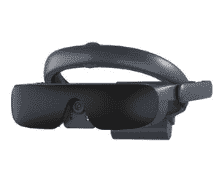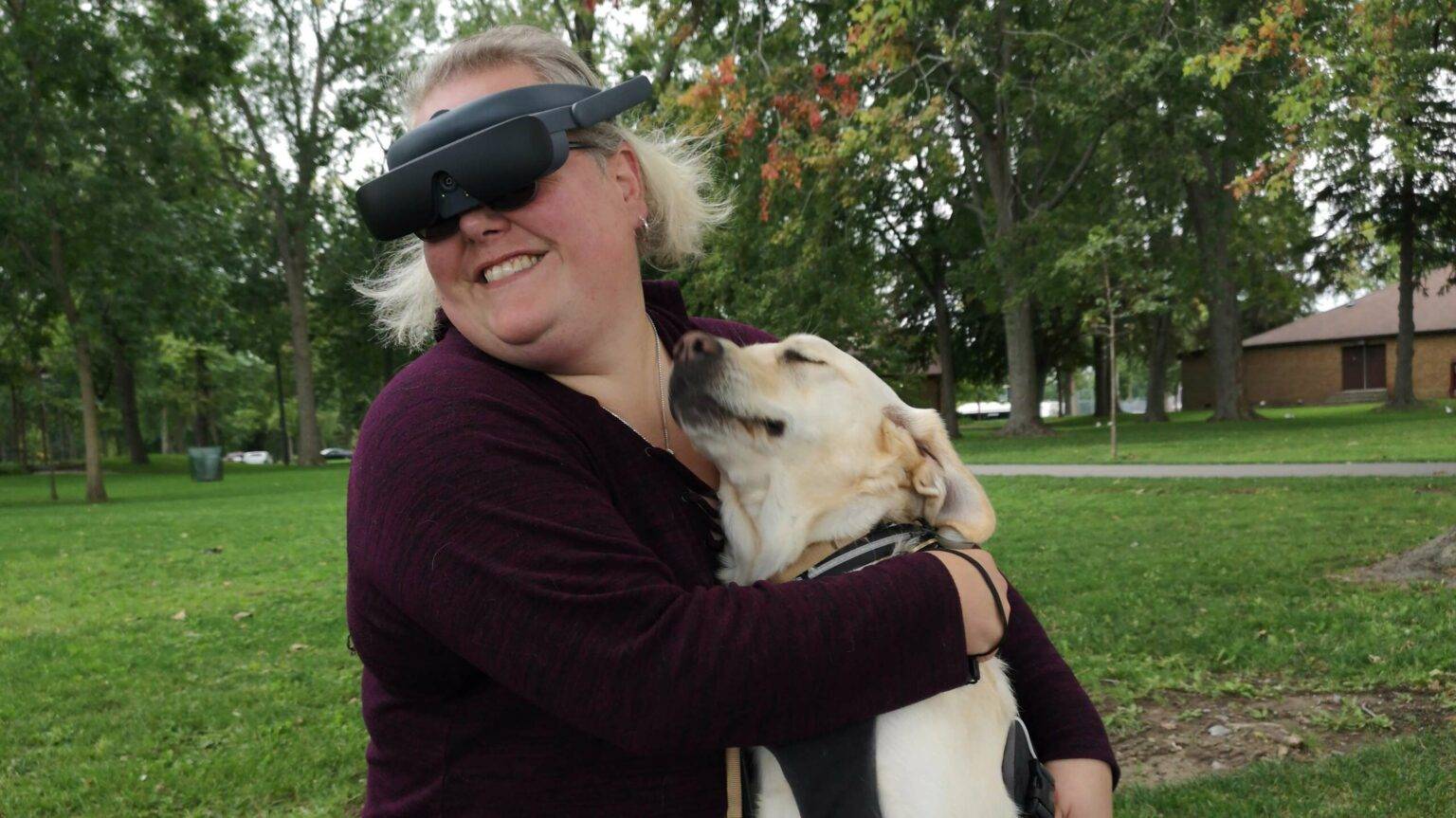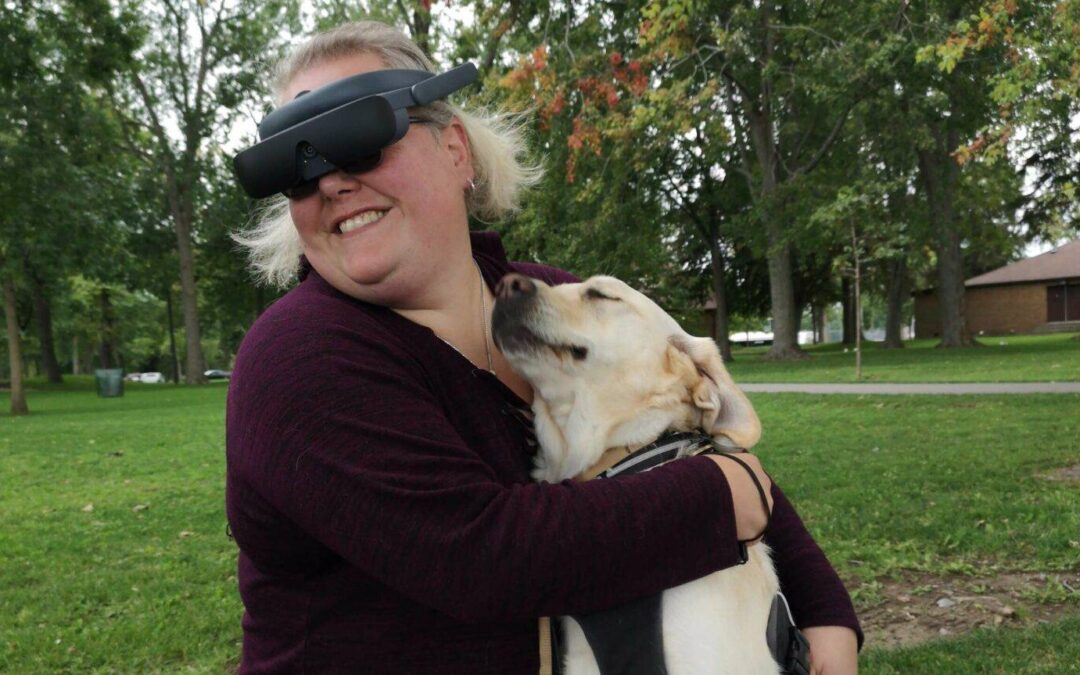Our interview with Jaclyn Pope on vision loss, accessibility, and assistive technology
Jaclyn Pope awoke one morning with huge dark floaters in her eye. She blinked a few times, hoping they would disappear. Unfortunately, the visual disturbance persisted. She went to see her local optometrist, who referred Jaclyn to a specialist. Two weeks later, the specialist informed Jaclyn that without treatment, she would lose her vision completely within 6 months’ time.
All at once, Jaclyn received a devastating slew of diagnoses: wet macular degeneration, diabetic retinopathy, glaucoma, and cataracts in both eyes.
To slow disease progression, Jaclyn underwent injections in both eyes and laser surgery. For a time, these treatments cleared her vision to the point where she could see relatively well wearing only glasses.
Sadly, in 2019 Jaclyn suffered a mini-stroke, which took away most of her remaining vision.
Jaclyn says when she first lost her sight, she felt like she had lost everything. But she persevered.
Thinking beyond the box
As she learned to navigate the world blind, Jaclyn began to realize she had a choice. She could choose to remain “in the box,” and grow increasingly frustrated and dispirited, or she could choose a different way of thinking. She could interpret challenges through a new lens.

One day after her diagnosis, Jaclyn and her cousin tossed an empty cardboard box to the ground, and proceeded to kick it, stomp on it, squash it, and jump on top of it. This exercise was a way for Jaclyn to diffuse some of her anger about her circumstances. Moreover, it provided the powerful, lasting imagery she would need to shift her thinking. She needed to let go of previous ideas and conceptions of what her life would look like. This was not “thinking outside the box,” this was thinking entirely beyond the box. It was a fresh start, a new chapter rife with opportunity, albeit unexpected.
There were roadblocks at every turn, especially at the beginning of the COVID pandemic, when services were shutting down. However, Jaclyn learned how to spot the issues quickly, and she began seeking opportunities to use her skills, her talents, and her voice to create positive change.
Losing her sight, finding her voice
Moving through her life and her community, Jaclyn started noticing the accessibility gaps for people who are blind or visually impaired. Still, she went beyond critiquing. She began brainstorming solutions and speaking up, eventually becoming both an advocate and agent for change.
For example, during the stroke that robbed most of her sight, Jaclyn endured a horrific experience at the ER. With ever-changing pandemic protocols, Jaclyn’s guide was not permitted to accompany her into the hospital. Alone and unable to see, she struggled to navigate the new system, eventually resorting to calling out loud until finally receiving assistance from security. In this moment of desperation, Jaclyn showed her true mettle. She spoke up until she received the help she needed.

“I have no problem standing up and screaming, ‘hey, let’s go, come on, let’s make a change.’”
— Jaclyn Pope, Legally blind Canadian using electronic glasses to develop more accessible apps
In losing her vision, Jaclyn has faced numerous accessibility issues with the tools required to manage her diabetes, from her insulin pump, to test strips, to the mobile app for her glucose monitor. It is a mountain of frustration, but one that helped inspire her new career path.
Pursuing a new goal

Originally pursuing environmental engineering, Jaclyn has now made it her goal to become a full-stack developer in order to make mobile apps (like the one she uses for her glucose monitor) more accessible to people with visual impairments. As she started deciphering the source code, she found that many of the apps she uses to manage her health could be made more accessible through simple changes to the code.
One such change that would have a big impact for people with visual impairments is improving compatibility with virtual assistants, like Siri or Alexa. Jaclyn decided she would be the one to start making these kinds of changes. Her decision required her to go back to school, a process which itself presented opportunities to advocate for the accommodations that would make it possible for her to achieve her goal.
It took extensive research, trial and error to identify the schools that demonstrated a sufficient commitment to accessibility through a willingness to meet her accommodation requests. Next month, Jaclyn will begin a six-week Frontend Introduction to JavaScript course with Lighthouse Labs, followed by a thirty-week Full-Stack Web Development program. Remarkably, Lighthouse is opening up the JavaScript course to Jaclyn free of charge. School administrators and teachers are taking this opportunity to receive and implement feedback from Jaclyn in order to create a more accessible learning environment in their classrooms.
Setting an example through self-advocacy
Prior to enrollment, Jaclyn shared with school administrators about her condition and worked with them to find solutions. The traditional “bootcamp” common for these types of programs – with class schedules typically running five or more days per week for over ten hours a day – would not be possible for someone like Jaclyn, who needs to balance essential, ongoing medical care with her coursework. She’ll be able to do so thanks to a part-time, flex-schedule format at Lighthouse Labs.
She’s also worked diligently with her school to make sure she has access to necessary class materials, such as class notes, recordings, and transcripts, plus timelines for projects so she can plan her medical appointments accordingly. Lighthouse continues to work with Jaclyn, keeping the lines of communication open to ensure she has what she needs to succeed. They want to learn from her how to be more accessible, and she has seen them actively putting her suggestions into practice.
Jaclyn has also received support from the Canadian Counsel on Rehabilitation and Work (CCRW) for tuition and the equipment needed for her classes. She is working on procuring the last few items she needs — like a printer, monitor, and workstation lights — through a publicly-available Amazon wish list.

In an interview with Mobile Syrup, Jaclyn points out the need for internationally accepted guidelines for mobile app accessibility, as well as the need to build accessible, responsive apps from the ground up, creating a better experience for everyone in the long run. Jaclyn also advocates for web accessibility training to begin in the classroom, where accessible web development should be central to the curriculum — not an afterthought. She believes laying the groundwork for accessibility in the classroom is the way to create sustainable change.
In the example she sets and the goal she pursues, Jaclyn is a leader for change, for breaking down barriers to uncover an accessible way forward.
Embracing assistive technology along the journey
Jaclyn has quickly adapted to the assistive technology solutions that have supported her access to a new career path and an independent way of life. Jaclyn was awarded an eSight 4 wearable device through the Canadian National Institute for the Blind’s scholarship program.
Transcript: Legally Blind Woman Goes Back To School With eSight


Jaclyn wearing eSight beside her guide dog, Luna. This month marks 1 year since Luna’s adoption. Image credit: eSight via https://mobilesyrup.com/2021/12/09/blind-canadian-jaclyn-pope-esight-4-accessible-apps/
Jaclyn uses eSight for everything from coding to shopping, cooking, reading, sewing, video games, traveling, and hiking with her beloved guide dog, Luna. With less eye strain, eSight has helped her be more productive and focused in her school work. She can see her computer screen cleaner and clearer. No longer hunched over a monitor, her back pain has dissipated, too. With all these benefits, Jaclyn has also noticed her mood and outlook improving over time.
But the best part about using eSight? The very first time she put on the glasses and turned them on, she was able to see her son for the first time in five years. He had grown from an adolescent to a young man during that time. It is a moment that Jaclyn will forever hold in her heart with gratitude.
Besides eSight, Jaclyn uses ZoomText and is considering various screen reader options. She is also a big fan of the free programs and web extensions that help make accessibility affordable to all.
A Day in the Life of Jaclyn Pope Infographic
JP “Why AT Matters to Me” Infographic Visual
Serving her community
Besides school, Jaclyn is currently working on several projects in collaboration with CNIB and other organizations. One such project is a campaign to have a CNIB Community Hub built in Durham.

Snapshots from CNIB Community Hubs. Source: https://cnib.ca/en/news/whats-all-hubbub-about?region=on_north
Community hubs are a lifeline for people who are visually impaired and their families, providing essential supports, education, and resources. According to the CNIB Foundation website, hubs create “heartbeats” in local communities, places where people can go to avoid isolation and find support. Right now, the closest hub for Jaclyn is in Toronto, which can take up to two hours of travel using public transit. Jaclyn is aiming to change that for everyone in her area by raising funds for a new hub in Durham.
She envisions a hub that everyone can call home — whether newly blind or blind from birth. She wants it to be a safe space for folks to experience community and camaraderie, both through in-person meet ups and virtual events. Traditionally, community hubs have provided a vast array of resources for the blind, from peer support, to enrichment activities in arts and music, to meeting essential needs like food, clothing, and housing. Jaclyn is working with CNIB to ensure that everyone in her area has access to this type of community.
Both CNIB and another organization, Make a Change Canada, have been helping Jaclyn open her own online business, Sewing in the Dark. Ultimately, Jaclyn plans to expand her business into Projects in the Dark, which will also incorporate her work in accessibility consulting and training. She is eager to connect with likeminded individuals who would be interested in partnering or mentoring opportunities with Projects in the Dark.
Always pushing forward and inspiring others to do the same, Jaclyn leaves us with this piece of advice for anyone struggling with vision loss.
“I would ask what makes them laugh and then say let’s go do it. If they say they can’t; ask why. Then find a way to do it. Nothing is impossible; we just have to change our way of thinking. Think outside the box as we no longer live in that box.”
— Jaclyn Pope
Thank you, Jaclyn, for this worthy reminder. Perhaps all of us should take a page out of your book and crush that box — it’s only cardboard, after all. Who knows what worlds could be awaiting us on the other side.
Author Information
By Bethany Wyshak. Reviewed by Stuart Flom.
Sources
Canadian National Institute for the Blind. (n.d.-a). Sewing in the Dark with Jaclyn Pope – a 2020 Scholarship Recipient. CNIB. Retrieved March 19, 2022, from https://www.cnib.ca/en/blog/sewing-dark-jaclyn-pope-2020-cnib-scholarship-recipient?region=on
Canadian National Institute for the Blind. (n.d.-b). What’s all the hubbub about? CNIB. Retrieved March 22, 2022, from https://cnib.ca/en/news/whats-all-hubbub-about?region=on_north
Shankar, B. (2021, December 9). Legally blind Canadian using electronic glasses to develop more accessible apps. MobileSyrup. Retrieved March 15, 2022, from https://mobilesyrup.com/2021/12/09/blind-canadian-jaclyn-pope-esight-4-accessible-apps/













